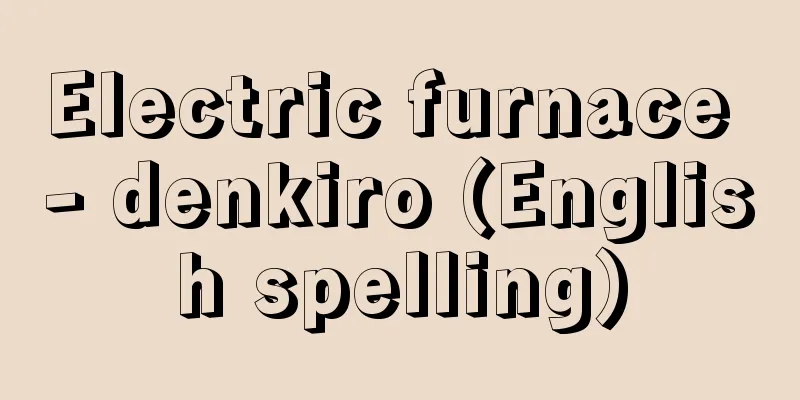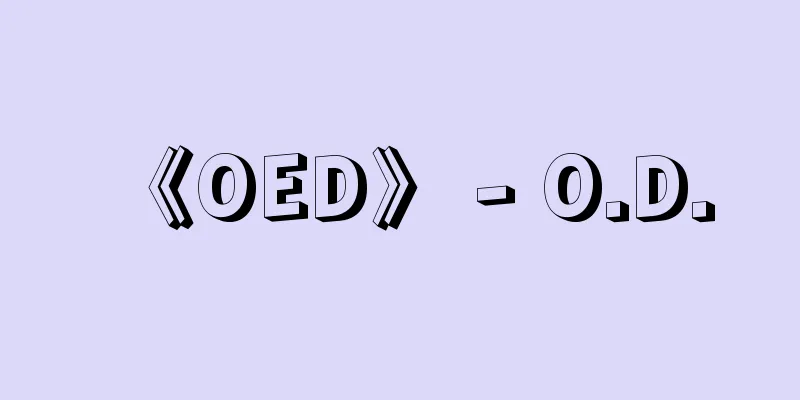Electric furnace - denkiro (English spelling)

|
A furnace that uses electrical energy as a heat source for heating, it is widely used not only in laboratories but also in the metal, machinery, chemical and ceramic industries. In the broad sense, electric furnaces can be classified by the heating method, including resistance furnaces, arc furnaces, induction furnaces, electron beam furnaces and furnaces that use thermal radiation. In general, electric furnaces do not produce waste gases and are easier to control the atmosphere inside the furnace than combustion furnaces that use fuel, and operations such as temperature control are also very easy and easy to automate. On the other hand, the conversion efficiency of electrical energy to heat is poor and they are expensive, so electricity costs become an issue in large-scale industrial furnaces. [Iguchi Yasutaka] Resistance FurnaceWhen electricity flows through an electric resistor, it heats itself by Joule heat, which is then used to heat the object being heated. Common heating elements used in air at temperatures below 1200°C include nickel-chromium, iron-nickel-chromium, and iron-chromium-aluminum alloys. At temperatures above this, platinum, platinum-rhodium alloys, silicon carbide, molybdenum disilicide, and lanthanum chromite are used. These have a limit of 1500-1900°C, but for even higher temperatures, zirconia and thoria are used on a smaller scale. In a vacuum or non-oxidizing atmosphere, high-melting point metals such as molybdenum, tungsten, and tantalum, as well as graphite, are used, and there are laboratory furnaces that can reach temperatures of over 2000°C. Metal heating elements are easy to process and can be made in any shape, such as wire, rod, plate, mesh, or cylinder, while nonmetal heating elements have fixed shapes such as rod or cylinder. The above are indirect resistance furnaces, but there are also direct resistance furnaces, which pass electric current directly through the object to be heated and heat it using the resulting Joule heat. These are used for producing carbide and artificial graphite, and for sintering powder molded products made from high-melting point metals. [Iguchi Yasutaka] Electric arc furnaceAn arc is generated between graphite electrodes or between the electrodes and the object to be heated, and the resulting heat is used to heat the object. There are indirect arc furnaces, direct arc furnaces, arc resistance furnaces, etc., many of which have large capacity and are very widely used industrially. In addition, plasma arc furnaces, which use high-temperature plasma of an inert gas, are also used industrially for special purposes. [Iguchi Yasutaka] Induction FurnaceA type of resistance heating in which electromagnetic induction induces a current in a conductive object or container inside a coil, generating Joule heat from this eddy current. It is used for melting metals and nonmetals, heat treatment, etc. [Iguchi Yasutaka] Electron Beam FurnaceHigh temperatures can be obtained locally by bombarding the object to be heated with electrons accelerated by high voltage (electron bombardment). It is used for melting high-melting-point substances and vacuum deposition. A tungsten filament is used, and the object to be heated or a tantalum crucible is used as the counter electrode. However, the atmosphere of the sample is a high vacuum. Unlike an arc furnace, it is easy to control. [Iguchi Yasutaka] Heat radiation furnaceThis furnace works on the same principle as a solar furnace, in other words, the heat generating part is separate from the part of the furnace where the sample is located, so it is easy to adjust the atmosphere around the sample. Some infrared image furnaces, which use infrared lamps as the heat source, can reach temperatures of 1400°C. Arc image furnaces, which use a carbon arc, can reach ultra-high temperatures of over 3000°C. These use a reflector or lens with a paraboloid of revolution to focus the light and heat the sample placed at the focus. This method makes it very easy to perform rapid heating and cooling. The reaction vessel is often made of transparent quartz, making it possible to observe the condition of the sample during heating. [Iguchi Yasutaka] [Reference] | | |©Shogakukan "> Principles of electric furnaces (resistance furnaces and induction furnaces) Source: Shogakukan Encyclopedia Nipponica About Encyclopedia Nipponica Information | Legend |
|
電気エネルギーを熱源として加熱する炉で、実験室だけでなく、金属、機械、化学工業、窯業をはじめ広く用いられている。広義の電気炉を加熱方式で分類すると、抵抗炉、アーク炉、誘導炉、電子ビーム炉および熱放射を利用した炉などになる。一般に電気炉は、燃料を用いる燃焼炉に比べ、廃ガスの発生がなく炉内雰囲気の制御が容易であるとともに、温度制御などの操作も非常に容易で自動化しやすい。一方、電気エネルギーの熱への変換効率は悪く、高価であり、大規模な工業炉では電力費が問題となる。 [井口泰孝] 抵抗炉電気抵抗体に電気を流すときに発生するジュール熱によりこれ自体を加熱し、その熱で被熱物を加熱する。空気中で1200℃以下で使用される一般的な発熱体にはニッケル‐クロム、鉄‐ニッケル‐クロム、および鉄‐クロム‐アルミニウム合金がある。これ以上の温度では白金、白金‐ロジウム合金、炭化ケイ素、二ケイ化モリブデン、ランタンクロマイトがある。これらは1500~1900℃が限度であるが、さらに高温では小規模であるがジルコニア、トリアなどがある。真空中または非酸化性雰囲気ではモリブデン、タングステン、タンタルなどの高融点金属や黒鉛が使われ、実験室的には2000℃以上の高温炉もある。金属発熱体は加工が容易で、線、棒、板、メッシュ、円筒状など任意の形状のものが得られるが、非金属発熱体は、棒状、円筒状など一定の形状である。 以上は間接抵抗炉であるが、被熱物に直接電流を流し、そのジュール熱で加熱する直接抵抗炉もあり、カーバイド、人造黒鉛の製造、高融点金属の粉末成形品の焼結などに用いられる。 [井口泰孝] アーク炉黒鉛電極間または電極と被熱物との間でアークを発生させ、その熱により目的物を加熱する。間接アーク炉、直接アーク炉、アーク抵抗炉などがあり、大容量のものが多く、工業的に非常に広く使われている。また、不活性気体の高温プラズマを用いたプラズマアーク炉も工業的に特殊用途に用いられている。 [井口泰孝] 誘導炉電磁誘導により、コイル内の電導性の被熱物または容器に電流を誘起させ、この渦電流によるジュール熱で加熱する抵抗加熱の一種である。金属、非金属の溶解、熱処理などに用いられる。 [井口泰孝] 電子ビーム炉高電圧で加速した電子を被熱物に衝突させること(電子衝撃electron bombardment)により局部的に高温が得られる。高融点物質の溶融や真空蒸着などに利用されている。タングステンのフィラメントを用い、対極として被熱物あるいはタンタルるつぼなどが用いられる。ただし試料の雰囲気は高真空である。アーク炉と違い制御は容易である。 [井口泰孝] 熱放射を利用した炉太陽炉と同じ原理、すなわち発熱部と試料のある炉の部分とが離れている形式の炉であるので、試料部の雰囲気調整は容易である。熱源として赤外線ランプを用いる赤外線イメージ炉では1400℃の温度が得られるものもある。炭素アークを用いるアークイメージ炉では3000℃以上の超高温が得られる。これらは回転放物面をもつ反射鏡あるいはレンズを利用して集光し、焦点に設置した試料を加熱する。本法は急熱、急冷が非常に簡単に行える。反応容器は透明石英を用いることが多く、加熱中の試料の状況を観察することが可能である。 [井口泰孝] [参照項目] | | |©Shogakukan"> 電気炉の原理(抵抗炉と誘導炉) 出典 小学館 日本大百科全書(ニッポニカ)日本大百科全書(ニッポニカ)について 情報 | 凡例 |
<<: Electric rocket; electrical propulsion systems
>>: Electrical Union - Denkirengo
Recommend
Eötvös József
Born: September 3, 1813 in Buda [Died] February 2,...
The story of Münchhausen - The story of Münchhausen
The Tales of Baron Munchausen, also known as The ...
Depopulated areas
This refers to areas designated pursuant to Articl...
Regent - Sessho
An important position that governs the country on...
Miserabilism (English spelling)
…Born in Paris. Having experienced the horrors of...
Herring roe hand - Herring roe hand
…(6) The double-sized puppet is from the wooden f...
Vedantasara (English spelling)
…He lived around 1500. His life story is unknown,...
Onibasu - Onibasu
It is an annual aquatic plant of the Nymphaeaceae...
Webster Catheter - Webster Catheter
...This method uses a cardiovascular catheter equ...
al-Ḥasā (English spelling)
A region in the central eastern Arabian Peninsula ...
Lee Yong-ik (English spelling) (R)I Yong-ik
1854‐1907 A Korean politician from Hamgyong Provin...
customer rate
…A swap transaction is a simultaneous transaction...
Nagamachi Woman's Harakiri - Nagamachi Woman's Harakiri
Joruri. Sewamono. Three volumes. Written by Chikam...
Mediastinal tumors
...This is called pneumomediastinum. [Mediastinal...
The Buddha's Body Theory
An ontology of Buddha that discusses the essence o...









